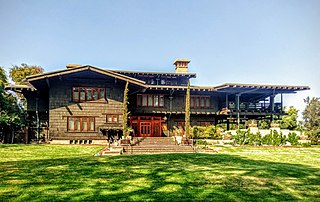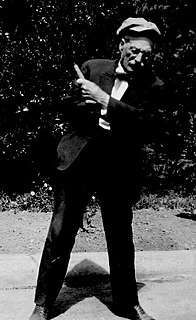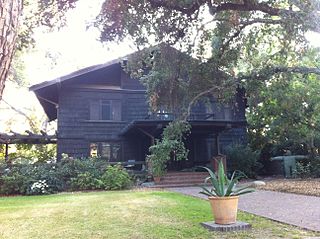
Pasadena is a city in Los Angeles County, California, 11 miles (18 km) northeast of downtown Los Angeles. It is the most populous city and the primary cultural center of the San Gabriel Valley. With its substantial downtown area, observers consider it as either a suburb of nearby Los Angeles, or as a significant urban center in its own right.

The Gamble House, also known as the David B. Gamble House, is an iconic American Craftsman home in Pasadena, California, designed by the architectural firm Greene and Greene. Constructed in 1908–09 as a home for David B. Gamble of the Procter & Gamble company, it is today a National Historic Landmark, a California Historical Landmark, and open to the public for tours and events.

The Batchelder House is a historic home built in 1910 and located at 626 South Arroyo Boulevard in Pasadena, California. An important center of Pasadena cultural life in its day, the home was designed and built by Ernest A. Batchelder, a prominent leader of the Arts and Crafts Movement, and his wife, Alice Coleman, an accomplished musician. The house, a large bungalow, has a "woodsy" design with elements of a Swiss chalet style. Batchelder's first craft shop was located in the structure, where decorative tiles were made for Greene and Greene, the Heineman Brothers, and other noted local architects of the era. Coleman also used the house's backyard stage to host chamber music concerts.

Frederick Louis Roehrig was an early 20th-century American architect. Roehrig was born in LeRoy, New York, the son of the noted "orientalist and philoligist," Frederick L.O. Roehrig. He graduated from Cornell University in 1883 and also studied architecture in England and France. His architectural styles evolved over time, covering the Victorian, American Craftsman, and Neo-Classical styles. Roehrig is particularly known for his many landmark buildings in Pasadena, California, including the Hotel Green, and Pasadena Heritage has occasionally conducted tours of Roehrig's buildings.

The Drake Park Neighborhood Historic District is located adjacent to Drake Park near the historic downtown area in Bend, Oregon, United States. Because of the unique and varied architecture in the Drake Park neighborhood and its close association with the early development of the city of Bend, the area was listed on the National Register of Historic Places in 2005.

Bungalow Heaven is a neighborhood in Pasadena, California named for the more than 800 small craftsman homes built there from 1900 to 1930, most of which still stand. Much of the area became a landmark district in 1989 and annual historic home tours have been conducted in Bungalow Heaven every year since then.

This is a list of the National Register of Historic Places listings in Pasadena, California.

Orange Grove Boulevard is a main thoroughfare in Pasadena and South Pasadena, California. Each New Year's Day, the Rose Parade participants and floats line up before dawn on Orange Grove Boulevard, facing north, for the beginning of the parade. South Orange Grove has been the address of the affluent, both the famous and the infamous, since the early 1900s. The Los Angeles Times said: "When a stranger comes to Pasadena now, the real-estate agent shows him Orange Grove Avenue.

The Richard and Mary Alice Frank House is a historic house located at 919 La Loma Road in Pasadena, California. Built in 1957, the house was designed by Buff, Straub, and Hensman. The stucco and wood home has a Modernist design influenced by American Craftsman and Japanese architecture. The home's design features gently sloped roofs with tongue-and-groove overhangs, an exterior with wide glass panels interspersed with thin wood and stucco sections, and exposed wooden framing.

The Lower Arroyo Seco Historic District is a residential historic district in Pasadena, California. The historic district encompasses homes located near the lower Arroyo Seco along Arroyo Boulevard, California Boulevard, La Loma Road, and Grand Avenue. The district includes 78 contributing homes, the majority of which were influenced by the Arts and Crafts movement. During the early twentieth century, when most of the homes in the district were constructed, Pasadena was one of three prominent centers of American Craftsman design, along with Chicago and the San Francisco Bay Area. The district includes a variety of Craftsman designs only matched by one other area in California, a hilly neighborhood in Berkeley. Several prominent architects, including Charles K. Sumner and Henry Mather Greene, designed homes in the district. The Batchelder House, home of tile designer Ernest Batchelder, is included in the district.

The Louise C. Bentz House is a historic house located at 657 Prospect Boulevard in Pasadena, California. Built in 1906, the bungalow was designed by prominent Pasadena architects Charles and Henry Greene. While the house has a typical bungalow design, its design also exhibits chalet influences in its overhangs and pitched roof and Japanese influences in the edges of the roof and overall horizontal emphasis. The house is the best remaining example of the houses the Greene brothers designed for middle-class Pasadena residents, most of which have been demolished or significantly altered. In addition, the house was the first built in the Prospect Park Tract, a neighborhood of historic homes designed by prominent architects. John Bentz, a significant Pasadena businessman and developer, commissioned the house.

Prospect Historic District is a residential historic district in Pasadena, California, consisting of homes along Prospect Boulevard and several surrounding streets. The district includes 108 residences and roughly encompasses the Prospect Park and Arroyo Park Tracts, a pair of early Pasadena subdivisions. Development on the Prospect Park Tract began in 1904, and the first house was built there in 1906. The Arroyo Park Tract was first surveyed in 1910, and its development soon followed; the two tracts were linked by the Prospect Boulevard Bridge, which was built in 1908. The houses in the district represent a wide variety of architectural styles and include works by several prominent architects, such as Frank Lloyd Wright's Millard House, Charles and Henry Greene's Bentz House, and a 1909 mansion designed by Alfred and Arthur Heineman. The varied architecture of the district's homes is united by its landscaping, particularly through the camphor trees which line its streets.

The Cordelia A. Culbertson House is a historic house located at 1188 Hillcrest Ave. in Pasadena, California. Built in 1911, the house was designed by prominent Pasadena architects Charles and Henry Greene. The Greenes designed the house in the Craftsman style; the design also features Chinese elements throughout, particularly on the south side of the home. Both styles frequently appeared in Greene and Greene's designs, and the house's U-shaped floor plan can also be seen in the brothers' other houses. However, the home features gunite exterior walls and a tile roof, a unique combination among the Greenes' works. An Italian garden is situated at the center of the home. The house was built for Cordelia, Kate, and Margaret Culbertson, three unmarried sisters; Cordelia, the eldest sister, officially commissioned the house. In 1917 the house was purchased by the wealthy widow Mrs. Dudley P. Allen of Cleveland, Ohio. She purchased it as a summer home that she enjoyed with her second husband Francis F. Prentiss, who later died there in 1937.

The South Marengo Historic District is a residential historic district located along South Marengo Avenue in Pasadena, California. The district consists of twelve Craftsman-style bungalows situated on the two blocks between Bellevue Drive and California Boulevard. The homes were built from 1901 to 1916, at the height of the bungalow's popularity in Pasadena. Several prominent local architects designed the homes, including Louis B. Easton, planner of the homes at 530 and 540 South Marengo; Easton's work was featured in Gustav Stickley's magazine The Craftsman. Marengo Avenue was considered an upscale district of Pasadena at the time, partly due to its well-designed homes and partly due to the pepper trees planted along the street.

The Raymond–Summit Historic District is a historic district roughly encompassing the 400 blocks of North Raymond and North Summit Avenues in Pasadena, California. The residential historic district includes 22 contributing buildings. The area was part of Rancho San Pascual prior to its development. In 1875, the Lake Vineyard Land and Water Company formed to manage the property. The company parceled out and sold the land and, between 1886 and 1904, the new owners built houses on their properties during a Pasadena building boom. Architectural styles represented among these homes include Queen Anne, Colonial Revival, American Foursquare, American Craftsman, Shingle Style, and a number of vernacular styles. Prominent Pasadena architects Greene & Greene designed a Shingle Style house at 450 North Raymond and two vernacular cottages at 442 and 448 North Summit; all three houses have Colonial Revival details.

The Ernest W. Smith House is a historic house located at 272 S. Los Robles Ave. in Pasadena, California. Prominent Pasadena architects Greene & Greene designed the American Craftsman house in 1910. The house was one of the last designed by Greene & Greene; however, its simple design is reminiscent of their earlier work. The house's interlocking gable roof with wide eaves was inspired by the Swiss chalet style, a design which Greene & Greene often incorporated into their work. The house's design also features exposed rafter tails, a full-length front porch, casement windows, and a wood shingle roof, all typical elements of Greene & Greene designs.

The W. L. Mead House is a historic house located at 380 West Del Mar Boulevard in Pasadena, California. Architect Louis B. Easton designed the American Craftsman house, which was built for W. L. Mead in 1910. The house is a two-story wood-frame structure with a brick foundation. The front-facing gable roof has wide eaves inspired by the Swiss chalet style. Both the roof and the second floor of the house are sided with wood shingles, a distinctive Craftsman feature; the first floor has a stucco exterior. The house also features a terrace covered by a wooden shed roof and supported by brick piers.

The Samuel Merrill House is a historic house located at 1285 N. Summit Ave. in Pasadena, California. Noted Pasadena architects Charles and Henry Greene designed the American Craftsman style house, which was built for conservationist Samuel Merrill in 1910. The single-story, "L"-shaped house is built from redwood and Arroyo stone, giving it a natural appearance; it also uses clinker brick for decoration. The house's gable roof features overhanging eaves and exposed rafter tails, characteristic features of Craftsman design. Several pairs of banded casement windows, many with wooden frames, are located throughout the facade. The house is considered one of the best-preserved small houses designed by Greene & Greene.

The Henry A. Ware House is a historic house located at 460 Bellefontaine Street in Pasadena, California. Prominent Pasadena architectural firm Greene & Greene designed the American Craftsman style house, which was built in 1913. The house's roof has a complex gabled form typical of Craftsman designs, and its eaves are overhanging with exposed rafters and beams. A large front-facing gable features a stepped brick chimney, while a one-story bay includes Tudor-inspired half-timbering.

The Park Place–Arroyo Terrace Historic District is a residential historic district located in northwest Pasadena, California. The district includes eleven contributing houses built from 1902 to 1912. Most of the houses in the district were influenced by the Arts and Crafts Movement, which was popular in Pasadena in the early 20th century; particular styles in the district include the American Craftsman house, the Craftsman bungalow, the Colonial Revival house, and the Prairie School house. Prominent Pasadena architects Charles and Henry Greene designed seven of the district's houses; the district is the most concentrated collection of their works in Pasadena. Two other noted Craftsman architects, Myron Hunt and Sylvanus Marston, also designed homes in the district, including Hunt's own residence.

























